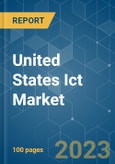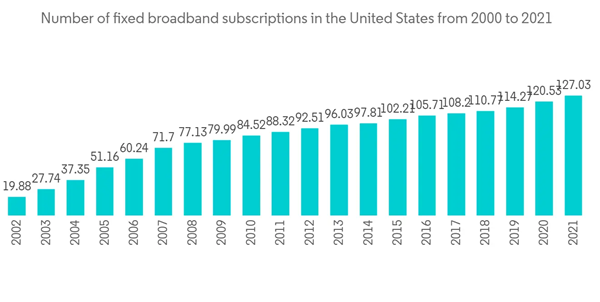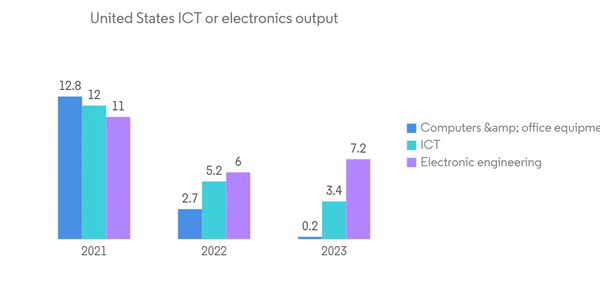Key Highlights
- The United States is the largest technology market in the world. Although information and communication technology (ICT) is present everywhere, it plays a significant role in the economic development of the United States. The ICT market in the United States was projected to represent approximately 35% of the world in 2022. Since the post-World War II industrial revolution, innovation has been a defining characteristic of the Unites States' competitiveness and has fueled the country's global dominance.
- The computer and information technology and telecommunications industry in the United States has a reputation for developing dependable and efficient products that reach the market quickly. The United States market attracts the attention of numerous international corporations with its strict enforcement of intellectual property regulations. The software and tech services sectors account for over half the spending in the country's tech market. With a stable overseas market share, US businesses dominate the global packaged and custom software marketplaces and are competitive in all other market areas.
- The 'digital economy' concept refers to products and services that incorporate or are produced utilizing digital technologies. The information and communications technology (ICT) sector supports the digital economy and is a reliable barometer of the country's economic growth. In this digital era, the competitive advantage of the United States would be driven by innovation, entrepreneurial dynamism, information, and ICT production.
- However, trade disputes have permeated the technology sector, with measures adopted by the Trump and Biden administrations to stop Chinese firms from purchasing American semiconductor manufacturing processes and machinery. The relationship between China and the United States continue to deteriorate, which could have a detrimental impact on global ICT/electronics supply chains and result in technological differences (such as the deployment of 5G) and reduced productivity.
- Encouragingly, government investment in 2022 would devote a sizeable portion to improving information technology system innovation and cyber security. According to a GovConWire report, the federal government of the United States allocated about USD 58.44 million for the fiscal year 2022 to meet the information technology requirements of civilian federal government agencies. Cyber security investments take up a large portion of the US government's technology budget. The funding for cyber security in 2021 was nearly USD 18.78 billion.
- The COVID-19 pandemic significantly impacted the US technology and telecommunication industry and other facets of daily life . The pandemic substantially harmed the country's technology industry, influencing the availability of raw materials, upsetting the electronics value chain, and increasing the danger of inflation for goods. The disruption accelerated remote work and shifted attention to quickly assessing and de-risking the entire value chain. A large portion of the US population were forced to spend constant time at home due to the pandemic, which increased remote jobs, telemedicine, online education, and streaming in-home entertainment. The high demand for mobile and residential broadband access bolstered the telecommunication sector.
United States ICT Market Trends
Rising Demand for Telecommunication
- The US telecom industry was moving forward with expanding its network capacity through new fiber and wireless deployments in 2021 to accommodate the rising demand for faster networks. The US telecom sector substantially expanded network capacity through fiber and wireless deployments. For over 20 years, AT&T, Verizon, and T-Mobile, the big three conventional companies in the United States, have been the backbone of the telecom infrastructure.
- The United States is home to most leading global telecom companies, who drive most of their telecom innovation by investing in R&D. Though the adoption of 5G technology is still in its early phases, AT&T, Verizon, T-Mobile, and U.S. Cellular are already creating a roadmap for the implementation of next-generation 6G via strategic alliances. The demand for services like OTT (over-the-top) media, communications, and e-commerce is growing. The United States has the most significant levels of digitization in the world, spurring more innovations and industry expansion.
- As discussed in the GSMA report, the mobile economy North America 2022, the overall consumer interest in upgrading to 5G is rising. Current 5G customers show increasing interest in expanding their 5G plans to include more content and services (such as live sports, music, gaming, and cloud storage). Interest in entertainment experiences and apps that use the high-bandwidth capabilities of 5G networks is also rising. 5G residential broadband is in high demand, though fixed wireless access (FWA) networks have been available for more than ten years.
- The COVID-19 pandemic profoundly affected the people of the United States in many spheres of life. Large segments of the population were compelled to spend time continuously at home, which increased the need for remote employment, telemedicine, online learning, and streaming entertainment. Network providers have been able to meet the surprisingly strong demand for mobile and home internet connectivity and capacity so far.
- Furthermore, the ever-increasing demand for internet access is largely dependent on fixed broadband networks. As per the International Telecommunication Union (ITU) report, there were 127 million fixed-broadband subscriptions in the United States in 2021, a modest rise from the year before. The number of fixed broadband subscriptions in the United States has risen steadily during the time under study.
Sales and Production Growth is a bit Slow but Nevertheless Significant
- Despite a little predicted slowdown in growth from the previous year, ICT production and sales in the United States remain solid. Home office equipment, connectivity-related accessories, cloud services, mobility solutions, and network security products continue outperforming the market. However, persistently rising inflation may have a detrimental effect on families' discretionary spending, which would probably lead to fewer purchases of devices. A report by Atradius anticipates that after a robust 11.5% growth in 2021, the output of consumer electronics in the country will only expand by 1.5% in 2022.
- Chips are increasingly required for data production, transport, processing, and storage due to the exponential expansion of data. China and the United States lead digital technology advancements. However, China does not play a significant role in the semiconductor business. According to the UNCTAD report, in 2020, the United States accounted for 47% of all sales. The production of computers, telecommunications equipment, and consumer electronics decreased because of the prolonged semiconductor scarcity. However, electronic components (including chips) are anticipated to rise by 8.5% in 2022.
- Meanwhile, the demand for chips is likely to outpace supply through 2023. The war in Ukraine has an unfavorable effect on chip producers, especially since two of Ukraine's biggest makers of neon gas stopped generation. However, prime US chip producers tend to keep a large amount of reserve to combat the situation.
- As per the Atradius report, semiconductor sales prices rose by 15% on average in 2021. ICT businesses confront higher vitality and transport costs (especially, charges for shipping holders have expanded considerably). Some firms may have to bear the high expenses of airfreight to satisfy customer demand on time due to supply-time delays. The profit margins of US ICT companies grew considerably due to the high demand in 2021. In the upcoming twelve months, profit is expected to remain at the same level as demand for all main product categories slow slightly, and market competition remains fierce.
- Underfunding the domestic ICT workforce and STEM education endangers the industry's capacity to meet the rising demand for essential ICT goods, influencing the execution of federal and state-funded projects and policies to boost domestic manufacturing. Government investment in 2022 would devote a sizeable portion to improving technology systems, communication services, and cyber security. The key areas of federal ICT investments include funding the US workforce, aiming to advance science and technology, and, most importantly, creating a better broadband workforce.
United States ICT Market Competitor Analysis
The US ICT market is highly fragmented due to the presence of many players. Several key players in the ICT market are in constant efforts to bring advancements. A few prominent companies enter collaborations and expand their footprints in developing regions to consolidate their positions. Tata Consultancy Services Limited, Microsoft Corporation, International Business Machines Corp., AT&T Inc., Verizon Communications Inc., and others are the major players in the market.- In July 2022, AT&T announced offering AT&T Fiber customers new, advanced security features. Customers of AT&T Fiber already have free access to AT&T ActiveArmorSM internet security features, including Weak Password Detection, Connected Device Monitoring, and Malicious Site Blocking, which automatically protects them from sites that are at risk of malware. For a nominal monthly fee, qualifying AT&T Fiber customers may also benefit from the new Advanced Privacy & Protection Features through the Smart Home Manager app.
- In October 2022, Microsoft unveiled its innovative ideas for the next phase of Windows PCs, in which PCs and the cloud merge and take advantage of cutting-edge AI technologies to unfold new experiences. Thus, users can take part, be heard, seen, and creatively express themselves. Moreover, advancements at the start of this journey helped unlock creativity and potential for years, enabling new levels of productivity.
Additional benefits of purchasing the report:
- The market estimate (ME) sheet in Excel format
- 3 months of analyst support
This product will be delivered within 2 business days.
Table of Contents
Companies Mentioned (Partial List)
A selection of companies mentioned in this report includes, but is not limited to:
- International Business Machines Corp. (IBM)
- Microsoft Corporation
- Adobe Systems, Inc.
- Oracle Corp. (ORCL)
- Cognizant
- Wipro Limited
- HCL Technologies
- PayPal Holdings
- Capgemini SE
- AT&T Inc.
- Verizon Communications Inc.
- Comcast Corporation
- T-Mobile US, Inc.
- United States Cellular Corporation
- Charter Communications, Inc.
- Lumen Technologies, Inc.
- Cox Communications, Inc.
- Altice USA, Inc.
Methodology

LOADING...










